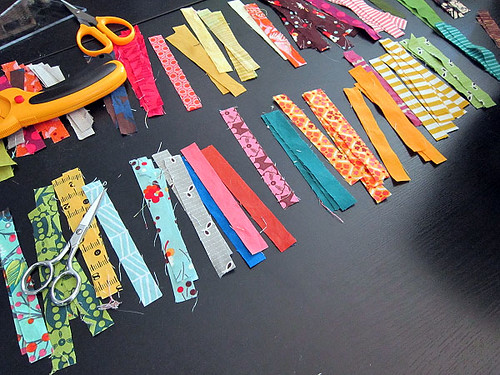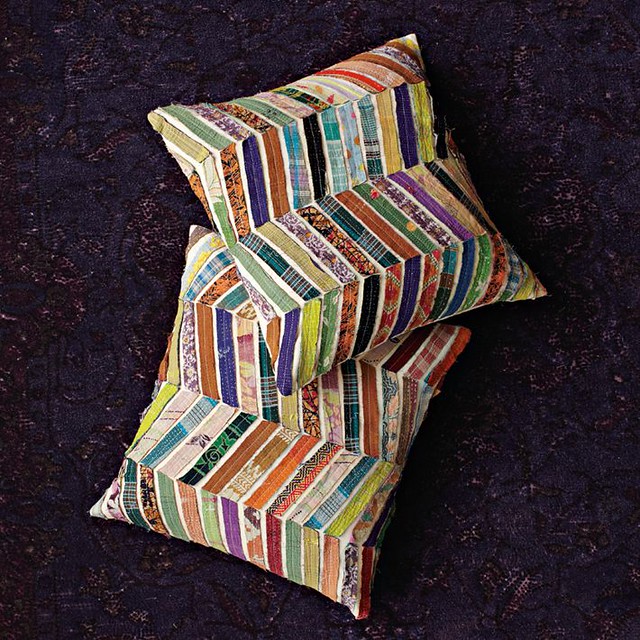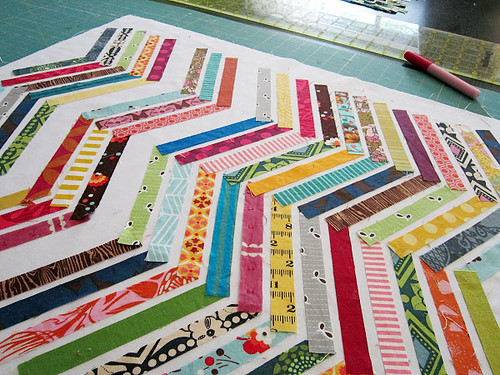Copied or Inspired? my answer
Ethics and legality - two sticky issues for any artist, especially an artist who profits from her work. If you take sponsors on your blog or make stuff to sell, on any scale, you are in some sense creating "for profit." Now I know that most of us don't make back enough to cover our expenses and this is a hobby community after all, but it still puts us in a position where ethics and legality come to the surface.
Last week when Maureen asked a question based on her own response to these West Elm pillows, I think it was pretty easy for folks to agree that there's nothing wrong with making something very similar to an item you see online or in store, so long as you're making it for yourself (i.e. not to sell). There seems to be a common feeling that if you can make it for yourself, by all means do! Some prefer to buy from the artist when the artist is "indie" (selling on Etsy, for example), but don't feel this same pull with items from corporations like West Elm, Anthropologie, Target.
Ok, but what about the stickier questions? The ones that actually apply to me, for example (and also to so many of you)! Anything I make and share on this blog I "profit" from, since I have paid sponsors. If I were to make a free tutorial, it would drive traffic to this space. If I were to make a pillow like that and sell it at my craft show, I'd also stand to gain. This arena of what counts as "inspired by" and what counts as "copied from" is a practical concern to me. And, I bet it's also a practical concern for many of you too.


So, I did. I spent some time thinking about this. My policy with tutorials and patterns has always been to freely allow folks to sell the things they make, if they like (but not to mass-produce). I feel that I'm putting it out there and so, of course, people will want to make to sell sometimes. That's the nature of crafting! If there were a pattern that was so important to me that I wanted to use it exclusively, it would be better for me not to make it public. But even then, someone clever would eventually figure it out themselves. And... that would be FINE! I don't own the ideas. Ideas are human rights that spread like a glorious wildfire in our newly connected world. I own my own interpretation, my words, my pictures.

Now, yes, it's great when people do credit the artist when they use someone's pattern or tutorial. That's being polite and honest (this is ethics). But sometimes people won't even remember where they got an idea from. Happens to me too, I'm sure! I'm not going to get upset because I think they used my idea and didn't credit me. They may have come up with the same idea all by themselves, after all! Coincidences happen and great minds think alike. And that's one reason why I don't think this kind of credit should be a legal requirement.
So, back to the pillows. I decided to illustrate my thoughts by making a project, which I intend to sell, that is inspired by the West Elm pillows. What do I like about those pillows? The scrappy raw edge applique (I've done that before) and the chevron shape, which is all the rage these days. Neither are original thoughts, so I would feel legally safe to just copy the pillow as it is, with my own fabrics. Unlike a drawing of a person or animal or something, the chevron shape is a classic. No one "owns" it.
But, I wouldn't feel ethically sound with a straight, exact copy. I'd feel a little less as an artist. I'd be settling for "good enough" instead of 100% beyond reproach. If I'm going to make something to sell and I don't have the artist's expressed permission to copy, I hold myself to the standard of evolving, not copying, the idea.

So here's what I came up with. I didn't want to make pillows, I wanted wall decor. And, I didn't want to work in a square either. I used my favorite fabrics for a much brighter, "me" kind of color scheme. I played around with the fabrics until deciding to leave gaps in the larger work. But, actually, the smaller 8" x 10" pieces are my favorites. They look great no matter how you orient them, horizontal or vertical. Maybe I'll make another of the small ones!

So, this is my answer to the question, "What is copying and what is being inspired?" I felt that a physical response would be the most useful. It's ok if you disagree. Ethical questions are never cut and dry. I'd love to hear what you think!
And I encourage you, along with Leah Day, to think about what kind of world you want to create in our industry. Do you allow others to make things for profit with your tutorials/patterns? How do you react when you see something made that's similar to yours with no credit given? Do you ask everyone for permission for every little thing, even when your work is evolved and unique? In doing so, aren't you creating a precedent that may have negative repercussions?
I've said it before and I'll say it again. Let's own our work, because actually virtually any sewn item is unique to the artist when you get down to it. And also, let's not own our work. Let's realize it's already owned by everyone else anyways.
Last week when Maureen asked a question based on her own response to these West Elm pillows, I think it was pretty easy for folks to agree that there's nothing wrong with making something very similar to an item you see online or in store, so long as you're making it for yourself (i.e. not to sell). There seems to be a common feeling that if you can make it for yourself, by all means do! Some prefer to buy from the artist when the artist is "indie" (selling on Etsy, for example), but don't feel this same pull with items from corporations like West Elm, Anthropologie, Target.
Ok, but what about the stickier questions? The ones that actually apply to me, for example (and also to so many of you)! Anything I make and share on this blog I "profit" from, since I have paid sponsors. If I were to make a free tutorial, it would drive traffic to this space. If I were to make a pillow like that and sell it at my craft show, I'd also stand to gain. This arena of what counts as "inspired by" and what counts as "copied from" is a practical concern to me. And, I bet it's also a practical concern for many of you too.

Reading the comments on Maureen's post sent me in to two very useful directions. First, I listened to a TEDTalks Beauty & Fashion episdoe via Netflix titled "Johanna Blakley: Lessons from Fashion's Free Culture". I learned that in the fashion industry anything goes. There's no legal protection against one's designs being copied to the "T". The only caveat is you can't copy someone's logo! The speaker explains, "Copyright law's grip barely touches the fashion industry... and fashion benefits in innovation and sales." Johanna Blakley holds up the fashion industry as a model, asking listeners to consider if their own industries would benefit from this environment. It got me thinking how like fashion is our "home decor" category, which includes quilts, pillows, wall hangings, etc. Our items are both useful and beautiful. It seems likely to me that in a court of law one would be able to protect oneself from a lawsuit for "copying" that West Elm pillow (as an example) drawing on the fashion industry's standards. I have not come across any info that suggests that there are different precedents in place for home decor. But you should know, I'm no lawyer!
Next I read this post from free motion quilting hero Leah Day. Her post, "Copyright Terrorism" is a very strong stance against "I own this" kind of thinking (and the TEDTalks video is imbedded in her post, as it turns out). Among other things, she addressed the legal debacle that most recently surfaced in our corner of blogland regarding the fabric designs of Kate Spain, a quilt and book made by Emily Cier and the tote bags which were produced by C&T Publishing. The alleged lawsuit was never brought to court so we don't know how the courts would have ruled. I don't bring up this post or the lawsuit so that we can argue about it. What I took away Leah's post was this part:
I'm all for sharing great products, and I love telling you all about the
tools and materials I'm using. It's when it becomes a REQUIREMENT to
tell you every tool, every material that went into a quilt, that makes
me very uncomfortable
If you want a quilting world where we all work in secret, creating in a void of new ideas and innovations just so your work can be "yours" to slap a copyright on, you can be guaranteed of one thing: failure.
Because no one wants to deal with this. No one wants the headache, the complication, the fear, or the negativity that this kind of attitude will bring. The more you shut down and lock up the quilting world, the fewer people will want to have anything to do with it...
If you want a quilting world where we all work in secret, creating in a void of new ideas and innovations just so your work can be "yours" to slap a copyright on, you can be guaranteed of one thing: failure.
Because no one wants to deal with this. No one wants the headache, the complication, the fear, or the negativity that this kind of attitude will bring. The more you shut down and lock up the quilting world, the fewer people will want to have anything to do with it...
Spend some time thinking about copyright today and what world you're helping to create with quilting.
A world where we share ideas, techniques, fabric, and tools as freely as our grandmothers around a quilt frame.
Or it could be a world locked tight by fear, lawsuits, negativity, selfishness, and egotism.
A world where we share ideas, techniques, fabric, and tools as freely as our grandmothers around a quilt frame.
Or it could be a world locked tight by fear, lawsuits, negativity, selfishness, and egotism.

So, I did. I spent some time thinking about this. My policy with tutorials and patterns has always been to freely allow folks to sell the things they make, if they like (but not to mass-produce). I feel that I'm putting it out there and so, of course, people will want to make to sell sometimes. That's the nature of crafting! If there were a pattern that was so important to me that I wanted to use it exclusively, it would be better for me not to make it public. But even then, someone clever would eventually figure it out themselves. And... that would be FINE! I don't own the ideas. Ideas are human rights that spread like a glorious wildfire in our newly connected world. I own my own interpretation, my words, my pictures.

Now, yes, it's great when people do credit the artist when they use someone's pattern or tutorial. That's being polite and honest (this is ethics). But sometimes people won't even remember where they got an idea from. Happens to me too, I'm sure! I'm not going to get upset because I think they used my idea and didn't credit me. They may have come up with the same idea all by themselves, after all! Coincidences happen and great minds think alike. And that's one reason why I don't think this kind of credit should be a legal requirement.
So, back to the pillows. I decided to illustrate my thoughts by making a project, which I intend to sell, that is inspired by the West Elm pillows. What do I like about those pillows? The scrappy raw edge applique (I've done that before) and the chevron shape, which is all the rage these days. Neither are original thoughts, so I would feel legally safe to just copy the pillow as it is, with my own fabrics. Unlike a drawing of a person or animal or something, the chevron shape is a classic. No one "owns" it.
But, I wouldn't feel ethically sound with a straight, exact copy. I'd feel a little less as an artist. I'd be settling for "good enough" instead of 100% beyond reproach. If I'm going to make something to sell and I don't have the artist's expressed permission to copy, I hold myself to the standard of evolving, not copying, the idea.

So here's what I came up with. I didn't want to make pillows, I wanted wall decor. And, I didn't want to work in a square either. I used my favorite fabrics for a much brighter, "me" kind of color scheme. I played around with the fabrics until deciding to leave gaps in the larger work. But, actually, the smaller 8" x 10" pieces are my favorites. They look great no matter how you orient them, horizontal or vertical. Maybe I'll make another of the small ones!

So, this is my answer to the question, "What is copying and what is being inspired?" I felt that a physical response would be the most useful. It's ok if you disagree. Ethical questions are never cut and dry. I'd love to hear what you think!
And I encourage you, along with Leah Day, to think about what kind of world you want to create in our industry. Do you allow others to make things for profit with your tutorials/patterns? How do you react when you see something made that's similar to yours with no credit given? Do you ask everyone for permission for every little thing, even when your work is evolved and unique? In doing so, aren't you creating a precedent that may have negative repercussions?
I've said it before and I'll say it again. Let's own our work, because actually virtually any sewn item is unique to the artist when you get down to it. And also, let's not own our work. Let's realize it's already owned by everyone else anyways.


